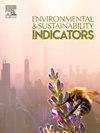Developing an indicator system and assessing China's progress on climate change adaptation in 2010–2022 from dual-dimension
IF 5.4
Q1 ENVIRONMENTAL SCIENCES
引用次数: 0
Abstract
China, as one of the regions most severely impacted by climate change globally, has consistently prioritized the issue of climate change adaptation. The Chinese government has implemented a series of measures to adapt to climate change in alignment with national economic and social development plans, yielding positive outcomes. Based on relevant theories, practices, and domestic and international strategic arrangements, we have developed an assessment indicator system from dual-dimension, encompassing both the adaptive stage and the adaptive sector, to assess China's progress in adapting to climate change over the period from 2010 to 2022. This system encompasses indicators related to the impacts of climate change, work progress indicators, effectiveness indicators, among others. The preliminary assessment reveals that since 2010, the influence of climate risks on China has exhibited an upward trajectory. Notably, China has continuously advanced its efforts in promoting adaptation concepts; enhancing monitoring and early warning systems; implementing disaster prevention and mitigation strategies; addressing public health concerns; while significantly improving adaptive capacities within key areas such as agriculture, forestry ecosystems; water resources management; infrastructure development. These endeavors have resulted in substantial adaptation effects and enhanced resilience. Looking ahead, this study will track the progress of climate adaptation actions in China, deepen the analysis of the sensitivity and relevance of adaptation actions, and aim to propose quantitative scientific methods to provide decision support for climate adaptation strategies. Horizontal gap analysis with countries shows that China's climate risks are higher than the global average. China's adaptive capacity and effectiveness still lag behind the international advanced values in 4 areas: disaster prevention, agriculture, forestry and ecology, and freshwater and Marine. In the areas of public health and infrastructure, China has reached or even exceeded the international advanced level. Future research should address issues such as incorporating adaptation costs into the indicator system, establishing long-term monitoring mechanisms for dynamic adjustments, developing local-level indicators, and analyzing the sensitivity and correlation of adaptation actions to enhance the scientific support for climate change adaptation work.
求助全文
约1分钟内获得全文
求助全文
来源期刊

Environmental and Sustainability Indicators
Environmental Science-Environmental Science (miscellaneous)
CiteScore
7.80
自引率
2.30%
发文量
49
审稿时长
57 days
 求助内容:
求助内容: 应助结果提醒方式:
应助结果提醒方式:


